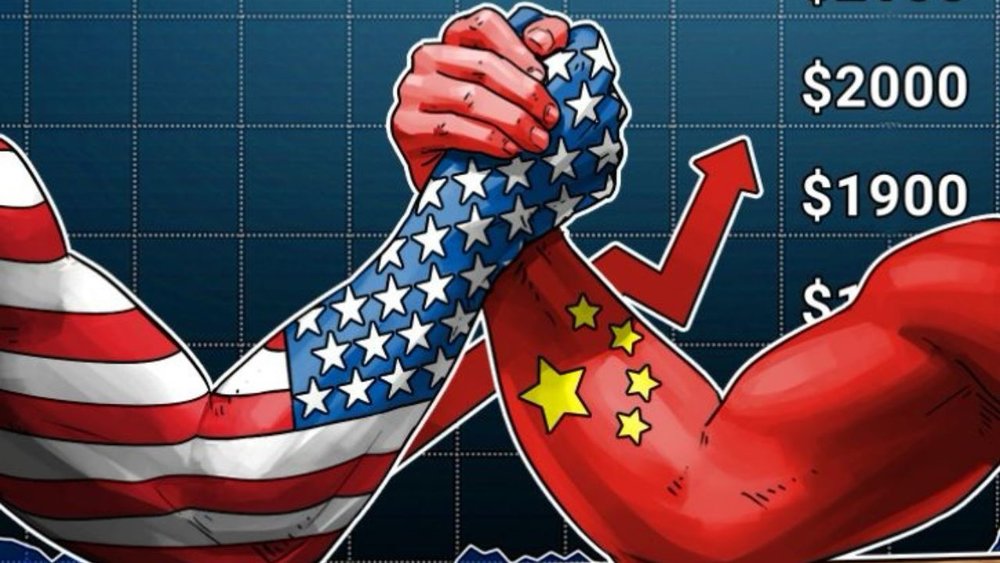U.S.-China Relations: Breakdown And The Looming Cold War

Table of Contents
Historical Context: From Cooperation to Confrontation
The trajectory of U.S.-China relations has been a complex mix of cooperation and conflict. Early engagement, following China's opening up under Deng Xiaoping, fostered economic interdependence and remarkable growth for both nations. This period saw significant trade increases and substantial Chinese investment in the U.S. market, creating a seemingly symbiotic relationship. However, the seeds of discord were sown early, with underlying tensions related to human rights, Taiwan, and intellectual property rights steadily escalating.
- Early engagement after China's opening up: The initial years saw significant diplomatic efforts and a focus on economic cooperation.
- Economic interdependence and growth: Both countries benefited immensely from increased trade and investment. China became a crucial manufacturing hub, and the U.S. became a major consumer market.
- Rising tensions over trade, Taiwan, human rights, and intellectual property: These issues became increasingly prominent as China's economic and military power grew.
- The shift from cooperation to strategic competition: The early 21st century marked a turning point, with the focus shifting from cooperation to strategic competition.
Trade Wars and Economic Decoupling
The escalating trade war between the U.S. and China, initiated during the Trump administration and continuing under the Biden administration, represents a significant turning point. High tariffs imposed by both countries disrupted global supply chains, impacting various sectors. The impact reverberated across the globe, causing uncertainty and affecting industries ranging from agriculture to technology.
- Impact on specific industries in both countries: Farmers in the U.S. and manufacturers in China faced significant challenges.
- The role of technology in the trade war (e.g., 5G, semiconductors): Control over cutting-edge technologies, particularly 5G and semiconductors, became a central point of contention.
- Efforts at decoupling supply chains and the implications for globalization: The aim to reduce dependence on each other has far-reaching consequences for global trade and economic interdependence.
- Discussion of potential future economic conflicts: The trade war serves as a precedent for future economic conflicts, highlighting the vulnerability of globalized economies.
Geopolitical Rivalry and Military Buildup
Beyond trade, geopolitical rivalry is a defining characteristic of the current U.S.-China relationship. China's increasing military spending and modernization, coupled with its assertive actions in the South China Sea and other regions, have fueled concerns in the U.S. and its allies. The competition for regional influence has led to the strengthening of alliances like the QUAD (U.S., Japan, Australia, and India) and increased focus on NATO's Indo-Pacific strategy.
- China's increasing military spending and modernization: China's military capabilities have grown significantly in recent years.
- Competition in the South China Sea and other regions: Territorial disputes and aggressive posturing in the South China Sea represent a key area of conflict.
- The role of alliances and partnerships in shaping the strategic landscape (e.g., QUAD, NATO): Alliances are playing an increasingly important role in countering China's influence.
- Cyber warfare and information operations: The use of cyber warfare and disinformation campaigns has become another facet of the geopolitical rivalry.
Ideological Differences and Human Rights Concerns
Fundamental ideological differences between the U.S. and China, particularly regarding human rights, significantly complicate the relationship. The U.S. criticizes China's human rights record, citing concerns about Xinjiang, Tibet, and Hong Kong. These issues have become focal points of international pressure, impacting diplomatic efforts and straining the relationship.
- Differences in political systems and governance models: The contrasting political systems – democracy versus authoritarianism – form a fundamental basis of disagreement.
- Human rights abuses in Xinjiang, Tibet, and Hong Kong: Reports of human rights abuses in these regions have drawn international condemnation.
- Impact of these issues on international relations and diplomatic efforts: These issues have hampered cooperation on other global challenges.
- The role of international organizations in addressing human rights concerns: International bodies play a role, but their effectiveness is often limited by political realities.
The Potential for a New Cold War
The deterioration of U.S.-China relations raises the unsettling prospect of a new Cold War. While not an exact replica of the previous Cold War, the current situation shares some worrying parallels. The potential for direct conflict, though hopefully avoidable, remains a serious concern, with proxy wars and cyber warfare representing significant threats. The existence of nuclear weapons adds another layer of complexity and risk.
- Defining characteristics of a Cold War: Key features include ideological rivalry, military buildup, proxy conflicts, and economic competition.
- Comparison with the previous Cold War: While the specifics differ, the underlying dynamics share some similarities.
- Potential for direct conflict or proxy wars: The risk of miscalculation or escalation remains a serious concern.
- The role of nuclear weapons: The presence of nuclear weapons significantly raises the stakes.
- Global implications of a new Cold War: A new Cold War would have profound and destabilizing consequences for the entire world.
Conclusion
The breakdown of U.S.-China relations is undeniable, and the potential for a new Cold War is a significant threat to global stability and the world economy. The escalating trade wars, geopolitical rivalry, ideological differences, and human rights concerns paint a complex picture of a relationship spiraling towards confrontation. Understanding the historical context and the current dynamics is crucial. Stay informed about the evolving situation in U.S.-China relations, engage in thoughtful discussions about the implications of a potential new Cold War, and explore further reading on this critical topic to understand the complexities of U.S.-China relations fully. The future of global peace and prosperity depends on it.

Featured Posts
-
 Us Protests Against Trump Voices From Across The Nation
Apr 22, 2025
Us Protests Against Trump Voices From Across The Nation
Apr 22, 2025 -
 Bmw And Porsches China Challenges A Growing Trend In The Auto Industry
Apr 22, 2025
Bmw And Porsches China Challenges A Growing Trend In The Auto Industry
Apr 22, 2025 -
 Technical Glitch Forces Blue Origin To Abort Rocket Launch
Apr 22, 2025
Technical Glitch Forces Blue Origin To Abort Rocket Launch
Apr 22, 2025 -
 Ai Transforms Repetitive Scatological Documents Into A Profound Poop Podcast
Apr 22, 2025
Ai Transforms Repetitive Scatological Documents Into A Profound Poop Podcast
Apr 22, 2025 -
 Major Bread Price Fixing Case 500 Million Settlement Hearing Scheduled
Apr 22, 2025
Major Bread Price Fixing Case 500 Million Settlement Hearing Scheduled
Apr 22, 2025
